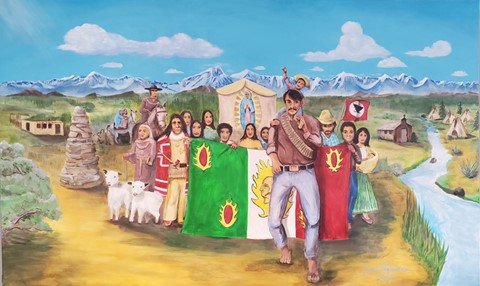The Civic Canopy has spent the past two years learning about the community of Montrose. In that time, the Canopy has gotten to know the neighborhood of Tortilla Flats. Tortilla Flats, like other Chicano neighborhoods across the state, has a rich history that’s at risk of disappearing as development forces change Colorodo’s landscape. Tortilla Flats is home to the Mexican American Development Association (MADA). A Catholic priest, Father Walter Smigiel, founded MADA as a neighborhood association to organize the farm workers and to create a community center for residents of Tortilla Flats and Chicano residents to gather. 50 years later a grassroots organization has grown into its own building.
A recent 50th anniversary celebration was a time to reconnect with the entire community. There was a dedication of the new mural painted by local artist Juan Espinoza who had originally painted a mural in the community room that was unable to be saved during the renovation due to asbestos on the walls, but who repainted an updated version of the original. Mr. Espinoza went on in his career to start La Cucaracha community newspaper in 1975 and then worked at The Pueblo Chieftain for 22 years. Chris Trujillo explained the mural to me as a representation of Tortilla Flats and the Chicano Movement and historical figures who created this space.
The central figure with a bullet belt around his torso is Ricardo Falcon, the community organizer killed in a racially motivated confrontation in New Mexico. He is holding a young child on his shoulders who also represents a small boy who was shot when he we trying to get his bicycle. Others in the mural included Francisco Atanasio Dominguez who crossed the river at Tortilla Flats in 1776, a resistant Ute tribal member who refused to leave Ute land, the Mexican penitents and La Morada, Mexican American shepherds and the original adobe apartments in Tortilla Flats, all this aside the Uncompahgre River at the crossing believed to be part of the Santa Fe trail at the location of Tortilla Flats. The modified Mexican flag depicts a face in the center with one side Mexican the other Native American and the front a combination depicting unity of the people.
A citizen’s committee is working with Hispanic Affairs Project to create a plan to protect the historic site of a Hispanic mutual aid religious society, La Morada. Since Canopy first entered Montrose the La Morada project came to light. There is an energy to mobilize to protect and honor their heritage through oral histories and through the La Morado cornerstone site.
The group requested assistance from Civic Canopy to help open the doors to the landowner and city before the massive pending development destroyed the site. Canopy has leveraged connections with a wide variety of actors to continue to draw attention to the mobilization effort of the local community. MADA also requested a Collective Impact training by Civic Canopy and will invite partners throughout the City of Montrose to join in the training. This is a first step in mobilizing advocacy as a collective process.


